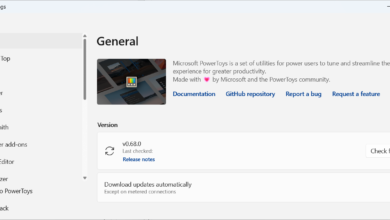Arc Browser is now available for all Mac users, Windows version in the works

Arc browser has graduated from beta to version 1.0. The Browser Company’s app is now available for all users on macOS.
Arc has been in development for 3 years, and until now the only way to access it was via a waitlist, aka a closed invite system. Let’s take a look at what it can do.
An overview of Arc Browser
Please treat this article as an overview of the features, not as a full review. You need to sign up for an Arc account to use the browser. You cannot do anything without signing in, it doesn’t even let you maximize the app’s window or access the settings. This was quite annoying, but I created an account using an email alias to jump over this hurdle.
Arc browser is based on Chromium, so it comes with its pros and cons. The important thing here is that Arc supports Chrome extensions, so you can install your favorite add-ons right away. Google is the default search engine in the browser, you can change this from the app’s settings.
When you visit a web page, you would normally look for a padlock icon to understand whether the current web page is secure or not. A couple of months ago Google said that users were being misled by the icon as they believed it represented a website’s trustworthiness. The Mountain View company is replacing the padlock icon with a details button in September 2023. Well, Arc is doing that already, but not directly on the address bar. You need to mouse over the URL bar and click on the details button, and the app displays a pop-up that tells you whether the site is secure.
Sidebar and vertical tabs
Arc browser has a sidebar oriented interface, i.e., everything that you do involves the side panel on the left for the most part. The top section of the sidebar has the navigation butttons (back, forward, refresh), and the address bar. The rest of the sidebar is divided into 3 sections, with vertical tabs.
The favorites section displays icons for your favorite sites, it almost feels like an app. You can add any site to this section, it supports Previews for a few sites. We’ll discuss this in a bit.
The next section in Arc browser’s sidebar are pinned tabs, which as the name suggests are tabs that will be saved permanently. The last of the 3 sections is called today tabs, these are unpinned tabs and are the default tabs that you open while browsing. You can pin a tab by dragging and dropping it to the pinned tab section, or by clicking on the pin button next to a tab. Unpinning a tab involves the same process.
Today tabs are are automatically archived (discarded) after 12 hours. You can tweak this option from the settings. You may also clear the unpinned tabs with one click. If you don’t want the sidebar to be displayed permanently, you may toggle it from the View menu. This option automatically hides the side panel, and shows it when you move the mouse cursor to the left edge of the screen.
Spaces and Folders
One of the unique features in Arc browser is called Spaces. A space is a unique sidebar where you can have a collection of tabs (tab groups). For example, your Work space can have a set of tabs, a Personal space may contain different tabs, and so on and so forth. You may customize it per your requirements.
To create a space, click on the + button at the bottom of the sidebar and select New space. You can rename it and change its icon too. Swipe with 2 fingers on the trackpad to switch between spaces, or click on the icons at the bottom of the sidebar. Your favorites (at the top) stay pinned across all spaces.
You can create folders to stash folders together for future access.
Ad Blocker
Arc comes with an ad blocker that prevents ads, trackers, and pop-ups on websites. It works on all websites, even on YouTube. So what’s really surprising here? The ad blocker is none other than uBlock Origin, the extension is pre-installed in Arc Browser. You can update it from the Chrome web store, remove it if you don’t like it, or install another extension of your choice.
Keyboard shortcuts and Actions
Arc supports a number of keyboard shortcuts. You can trigger them manually or by entering some commands in the command bar. To bring up the bar, press Command and L. It’s sort of like macOS’ Spotlight, and you can type some keywords to run an action. For example, to open new tab, pin a tab, etc.
Ctrl + Tab switches between your opened tabs, it also shows a thumbnail preview of each tab. This is quite similar to Command + Tab (Alt + Tab)
Mini Player
Arc has a mini player to play audio and video on websites. It is triggered automatically when you switch from the media’s tab. When a tab is playing a video, the mini player pops out into a floating video player aka picture-in-picture mode. It does not have a volume slider.
Notes, Easels and Boosts
Want to take notes while browsing the web? Arc has a Notes feature that you can access by clicking the + button at the bottom of the sidebar. Your notes are saved in the notebook automatically. The text editor has some basic formatting options including bold, italics, underlined text, lets you add numbered and bulleted lists, links, and images.
Arc’s Easel tool acts like a whiteboard, so you can draw on, write some text, or add images. Like Notes, Easels can be accessed from the browser’s sidebar. Once a note or easel has been created, you will find them in a pinned tab in the current space.
Arc Boosts are essentially customizable themes for websites. It lets you edit the font, colors, and the code (CSS, JavaScript). You can create a Boost by visiting a website and clicking on the paintbrush icon on the URL bar. Users can submit their created Boosts to the Gallery, to share them with other users.
Previews, Focus Mode, Split View and Little Arc
The Previews feature in Arc lets you preview some content (in favorite tabts) without switching tabs.
(Image via: The Browser Company)
It works with some websites automatically, including including Gmail, and outlook. This is a pretty neat way to check mails or join calls. Interestingly, this is not merely a hover preview feature, you can interact with the compact version of the preview.
The browser has a special feature called Little Arc, which can optionally open links in a smaller window. Alternatively, you may want to try the built-in Focus Mode for a distraction-free experience in full screen view. Split View in Arc lets you work with multiple tabs at once. You can drag a tab from the sidebar and drop it in the middle of the window to merge the tabs and create a Split View.
Arc browser lets you import your data from other browsers including Chrome, Safari, Firefox, Brave. You may customize your experience by setting a custom theme.
Arc browser for iOS
Arc for iPhone is available on the App Store. But this is not a web browser, it is a companion app that you can use it to access your spaces, tabs, Notes and Easels that you saved on your Mac. It can also be used to save links from other apps, so it’s kind of a read it later app.
I can’t say I’m impressed with the iOS app, it feels like Pocket, which is not a bad thing per se, but since it lacks the functionality of a proper browser, you will actually need to use it along side Safari or another browser of your choice.
The cons
The vertical tabs in Arc browser look cool, there’s no denying that, but it takes time to get used to the experience. Finding a specific tab by scrolling through the list does feel a bit slow, you may want to use the command bar for a faster way. Arc browser does not use your Google account to sync your data across your devices. It relies on iCloud to sync your spaces, folders, and tabs. On the other hand it does not sync your history, passwords, extensions, and profiles.
Tip: You may want to use a third-party password manager like Bitwarden (and use its Chrome extension) to sync your password across devices.
I would like to point out a couple of other things that might be of some concern to users. The first issue is that Arc browser requires an account to use the app, no other web browser does this. I think this could be a huge hurdle for Arc, a lot of people may not be comfortable with providing their email address to the service. You could do what I did and use an email-alias service like Firefox Relay, Simple Login, etc., which can mask your real email address and forwards the mails to your real inbox.
The other issue is that Arc browser is not open source. Though the browser is based on Chromium, it does have a unique design. I’m assuming the developers want to keep the source code private to protect their UI design, features and other customizations that they created, which is not unlike what Vivaldi does.
As far as privacy is concerned Arc browser says that the company says that it doesn’t track your visits to websites, what you type in or search for, it also promises not to sell your data to third parties. I’ll leave it to you to decide how privacy-friendly you think Arc browser is, you can find the privacy policy here.
I’ve been keeping an eye on Arc browser for a while, and have wondered why are other blogs going ooh, ah over it? Frankly it sounded like PR drivel that actually made me stay away from the app. Anyway, I decided to take a closer look and learn about it. Since I wasn’t looking to switch over from Firefox, I treated Arc from a neutral perspective, just to explore its features. I think it has a nice design, the tabs experience is rather unique, though the learning curve could be a slight issue.
Apple Safari is getting a feature similar to Spaces in iOS 17, and macOS 14 Sonoma, but Arc’s implementation of Spaces does seem to have an advantage. Each space in Arc has its own history, cookies, extensions, and settings. I haven’t used the browser long enough to test it extensively, but that’s what the developers claim it does. Could this actually be a competitor for Firefox Containers? I think more browsers need to support such anti-tracking options across websites. The other features that stood out to me in Arc were Ctrl Tab, Split View and Notes. These are nice quality-of-life options to have, but aren’t really required for the average user.
Try it for yourself, Arc browser is free on Mac. It is compatible with macOS 12 Monterey and above. You may want to check out Arc’s resources to learn more about the features in the browser.
That said, Arc browser still needs a lot of work in order to compete with the likes of Chrome, Firefox, Safari, Edge and Brave, if it aims to win users over from the competition. Supporting other platforms would be a good start, speaking of which, Arc Browser for Windows is in the works, and is being built with Swift. It will be released in Winter 2023, you can join the waitlist for it now. Arc for Android is also being planned.
Thank you for being a Ghacks reader. The post Arc Browser is now available for all Mac users, Windows version in the works appeared first on gHacks Technology News.
gHacks Technology News


